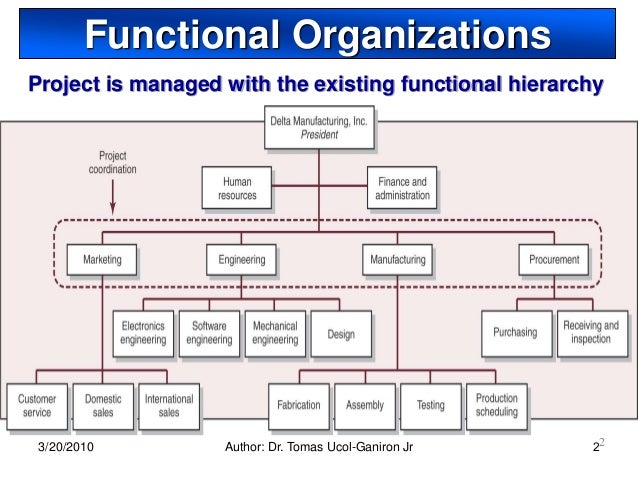Functional Organization :
All of the companies define its organizational structure to determine the reporting relationships that will exist in the company. It simply states who works for who. Organizations choose their organizational structure based on many factors like: size, its geographic location, the manner of delivering different products and services that they will offer.
A functional organization is the most common type of organizational structure. This is where the organization is divided into smaller groups based on its special functions such as IT, finance or marketing. This departmentalization allows greater operational efficiency because the employees have their skills and knowledge to be shared within the group. The basis of this functional organization structure is an arrangement where a worker has different managers for different areas of the organization operation. Since this type of structure has many departments, it could also have several reporting structures as well.
In a functional organization structure, the reporting relationships are grouped based on the specialty or functional area. Separate areas are established to take care of different concerns.

Functional Organization
The advantages of Functional Organization:
- The team is managed by an experienced person with a high ability and skills who can adequately understand and review the entire work.
- The team members work with other people in the field and it allows sharing of thoughts and knowledge to make the people learn new skills.
- The staffers have the chance to get promoted within their functional areas which can be a reason for them to stay long term. The company is getting the advantage of their expertise and knowledge.
- Because of people’s expertise, the workers with specialized skills can perform tasks quickly, efficiently and with more confidence, while reducing of work-related mistakes. The clear nature of the career path within the functional unit makes it possible for employees to be highly motivated to advance their careers as they move up within the hierarchy. This will keep them aiming for advancement and development.
- This can be an ideal structure for small businesses that focus on one product or service because you can maximize performance by encouraging peer cooperation among different units at various levels of management through supervision and coordination. Specialization leads to operational efficiencies and enhances productivity levels.
The disadvantages of Functional Organization:
- The functional organization may have unhealthy competition working with the other areas. There may be a lack of understanding as to how significant that specific are to the company. In one example, there may be a request from the marketing department which may not be prioritized in order to attend to the concerns of the sales department by adding more people. Ideally, the companies decide based on what is urgently needed.
- Because the people in the functional organization are grouped according to their special set of skills, roles or task, the entire team will operate well. However, the business strategies and the level of bureaucracy make it difficult to respond to changes immediately.
- Another disadvantage of functional organization structure is that these functional groups may not be able to communicate more often which decreases flexibility and innovation.
- When a company uses this type of structure, it groups its people according to their knowledge and skills which help them become specialists on that field. It also requires a management system which allows promotion, development and visibility of skills of people in each functional area. It helps to bring in-depth knowledge and skill development among the employees to achieve the goals of the company.
- Management issues may arise because it is more bureaucratic and the functional organization are not accountable to each other and the poor horizontal coordination within the department may occur. Employees’ motivation is greatly affected by lack of innovation and restricted views of organizational goals. This structure can be rigid and the standardized ways and high formalization can hamper or impede faster decision making.
- Another weakness of functional organizational structure is there could be lack of unit coordination. This means that though the functional units can perform with higher level of efficiency however, there could be difficulty working well with each other thus, cooperation is compromised. Some people may be territorial or there may be some who are unwilling to cooperate. These unhealthy coordinations may lead to delays, reduced commitments, competing interests, waste of time, and getting late in finishing the project.


No Comments